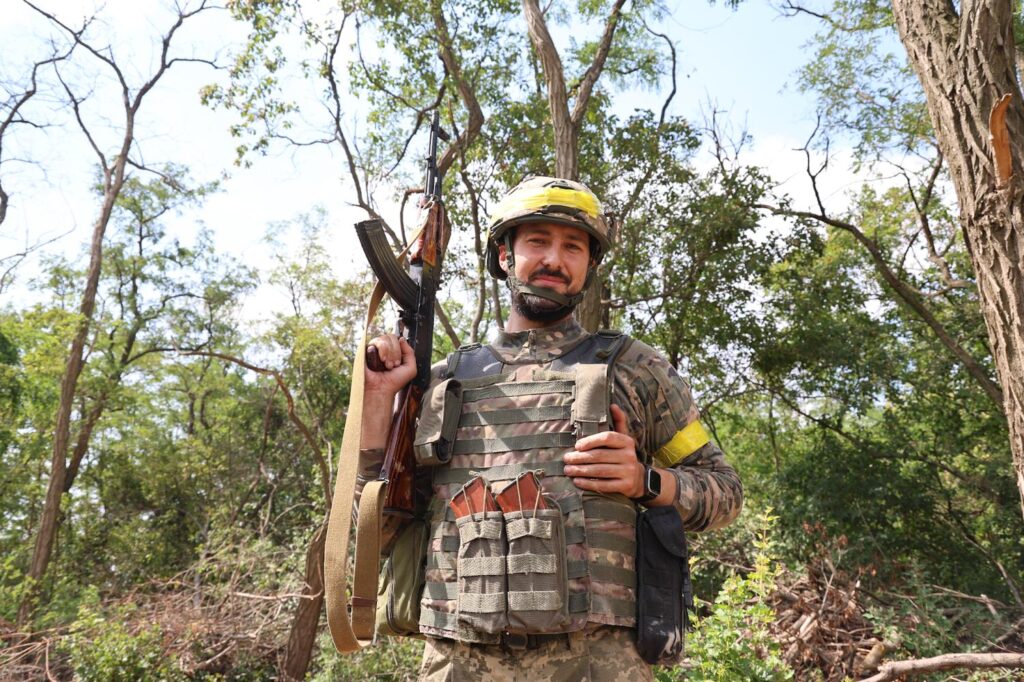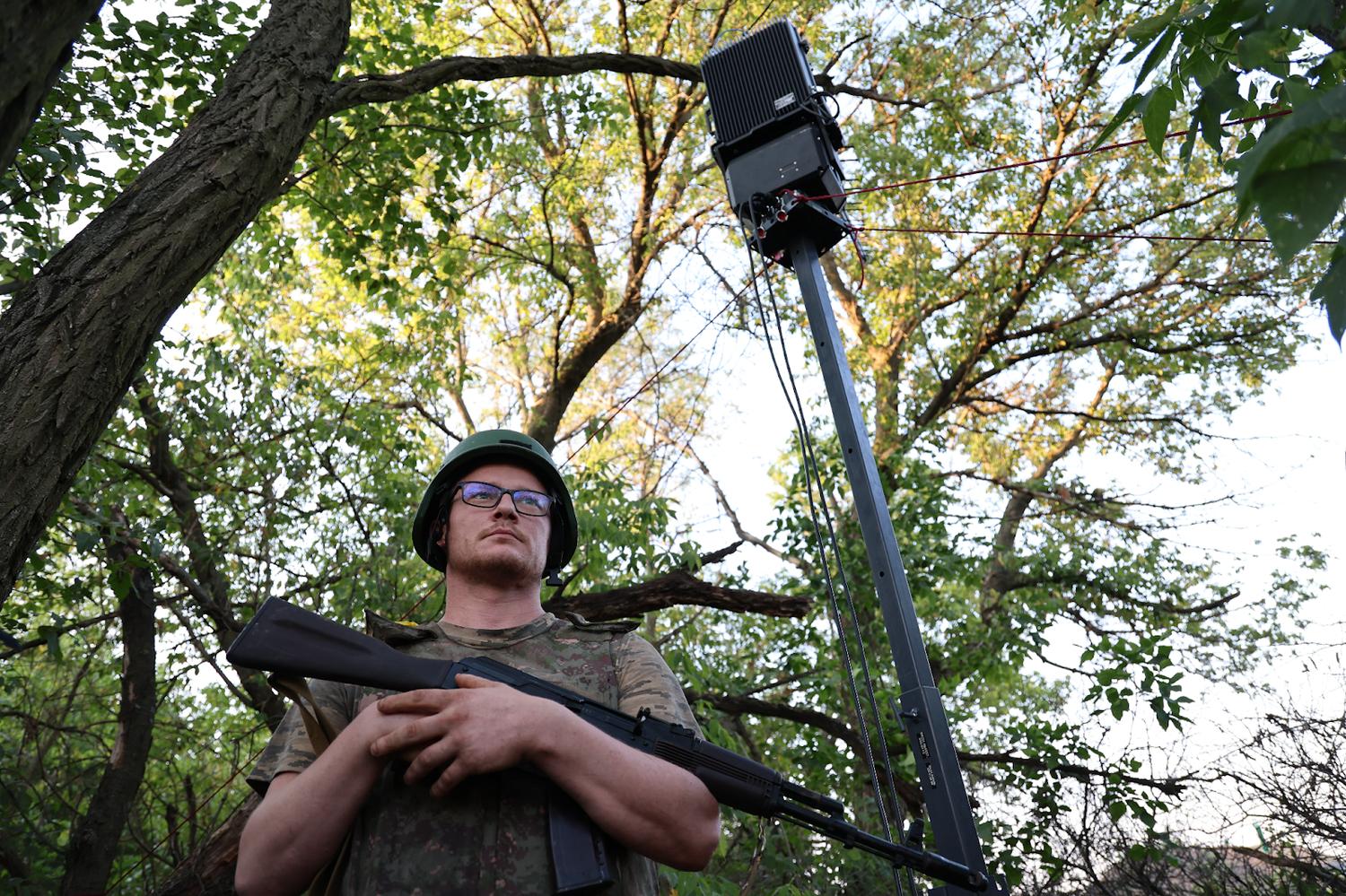Russia’s ongoing invasion of Ukraine has produced many surprises, least of which is the defiant resistance Kyiv has mounted for years now. But the war has also sparked a wave of technological innovation, one of the most important being the mass adoption of cheap drones.
While artificial intelligence has played a growing role on the battlefield, over the past year, fiber-optic drones have taken on a more central role.
“This isn’t a traditional war. It’s a war of drones,” said Vladyslav, an electronic warfare specialist serving in the 141st Separate Mechanized Brigade. He added that it’s “a war of technology.”
Ukraine has leveraged this technological edge masterfully, holding Russia at bay for several years. It has built a “drone wall” – a defensive network of drones that Russia continues to hurl wave after wave of soldiers into, suffering heavy losses in relentless meatgrinder assaults.
By mid-2024, Russia began deploying fiber-optic drones on the battlefield, beginning the process of eroding Kyiv’s technological edge. These drones are connected to operators by fiber-optic cables, making them both unjammable and undetectable to conventional electronic warfare systems.
Russia weaponizes the unjammable advantage
Fiber-optic drones played a key role in Russia’s successes in the Kursk offensive. The same tactics are now being replicated across the front:
- launching rapid motorcycle-borne assaults
- pressuring Ukrainian flanks
- attempting to encircle defenders
- and using fiber-optic drones to strike at Ukrainian logistics and vehicles.
Ukraine’s Commander-in-Chief, Oleksandr Syrskyi, acknowledged that Russia currently holds the advantage in the fiber-optic drone race “in terms of both quantity and range of application.” It certainly helps Russia from the close relationship they share with China, the world’s leader in fiber optics.
As a result, Kyiv is now scrambling to catch up to Russia’s fiber-optic advantage.
The elite Russian drone unit Rubicon has made very effective use of this technology. Specializing in long-range fiber-optic FPVs, Rubicon has launched deep strikes into Ukrainian rear positions, crippling logistics and command nodes.
Their presence on the Kostiantynivka front has forced Ukrainian brigades to rethink supply routes and drone deployment tactics.

Davyd, callsign “Poliak,” a drone pilot from the 419th Battalion of Unmanned Systems, has witnessed firsthand how Russian forces combine fiber-optic drones with high-speed motorcycle assaults on their positions.
“Out of ten motorcycles, five usually make it through,” he said, describing how standard FPVs first clear entry points before a fiber-optic drone flies directly into dugouts, forcing immediate evacuation.
In one instance, a fiber-optic drone destroyed their shelter after threading its way inside. “Luckily, everyone survived, but once they find you, you have to flee fast,” he said.
Ukraine adapts under pressure
So far, there are no scalable countermeasures against these fiber-optics.
“Shotguns are fairly effective. Scissors or a knife work great if one flies by and you can spot the fiber cable,” said Heiner Philipp, an engineer with Technology United for Ukraine.
“Higher-tech solutions like AI-powered automated turrets equipped with radar and camera sensors can shoot them down without human intervention, but they’re expensive and they still require people to supply ammo, fuel, and maintenance.”
However, it poses a strategic risk for Kyiv that much of its drone material is sourced from China – the same suppliers often provide components to both Ukraine and Russia.
Ukrainian President Volodymyr Zelensky has warned that China has begun restricting the export of Mavic drones to the West.
“India and other low-cost jurisdictions are already producing fiber, and we’ve begun buying from them to establish relationships,” Philipp added.
Still, Ukrainian drone pilots are adapting quickly. More and more of Ukraine’s reconnaissance is done via First-Person View (FPVs) now because of fiber-optics and “It’ll be cheaper than making fixed-wing drones,” said Bohdan, a drone operator in the Unmanned Systems Battalion of Ukraine’s 110th Separate Mechanized Brigade.
Fixed-wing systems, he explained, “only see from 300 meters up, at best. More like 500–600 meters usually. It’s hard to detect anything from that high. A fiber-optic drone can film from half a meter above the ground – or 3, or 10, or 100. It’s much easier to find something that way.”

He noted the drones typically have a range of 10 to 20 kilometers, though some other units have reached up to 32 kilometers. “But to do that, you need to fly low and in a straight line to prevent the cable from sagging or snagging on obstacles,” Bohdan explained.
“Fiber-optic drones can’t be jammed or tracked, which gives them a big edge,” he added. “But in winter, the cables can glint with frost, making them more visible. Still, if enough of them are in use, it becomes nearly impossible to trace them back to the operator.”
In response to these battlefield demands, Ukrainian companies like 3DTech have begun producing next-generation fiber drones with ranges up to 30 kilometers, optimized for low-altitude ambush strikes.

Surprisingly, Russian soldiers used scissors to down a Ukrainian fiber-optic drone — but Kyiv also knows a trick or two
Global logistics impact
Andrii, known as Murphy, from the 419th Battalion of Unmanned Systems, said they survived a close call recently. His team narrowly escaped when an FPV drone targeted their vehicle, managing to abandon it just before impact.
The strike destroyed the car and all their equipment, and afterward, they discovered enemy fiber-optic lines in the area.

As a result of these drone attacks, Ukraine is facing an acute shortage of trucks, pickups, and armored transport vehicles, which are increasingly being destroyed.
Across the front, it’s now common to see Mad Max–style vehicles – improvised trucks reinforced with metal cages to protect against drones.
Volunteer groups and charities have stepped in to supply thousands of replacements, but demand continues to far outpace supply. As a result, Kyiv is becoming more reliant on unmanned ground vehicles (UGVs) to carry out frontline logistics and resupply missions.
Yevhen, a UGV company commander in the 92nd Assault Brigade, said his team is developing a mobile platform to launch kamikaze drones using fiber-optic links. These links are immune to jamming but vulnerable to being severed by other drones crossing their path.
To reduce that risk, most systems now combine fiber with a radio backup to ensure reliability.
Technology spreads beyond Ukraine
The reach of fiber-optic drone warfare is also expanding beyond Ukraine. Reportedly for the first time in Mali, the use of fiber-optic FPV drones was observed by the Azawad Liberation Front (FLA), which is fighting against both the Malian government and the Russian African Corps. In Myanmar, rebels from the Kachin Independence Army (KIA) reportedly used a fiber-optic FPV drone to down a Mi-17 helicopter.
Sometimes, the most practical solutions such as the use of fiber-optics prove to be the most effective. The technological race on Ukraine’s battlefields is advancing rapidly, and militaries around the world are paying close attention.






